Torch and Torch Relay
| THE OLYMPIC TORCH RELAY
In 2000, as the Olympic flame travelled first through Greece, then through Oceania and finally around Australia, athletes across the world were beginning to make their way to Sydney for training and to celebrate the Games of the XXVII Olympiad. In every Greek town and village that the torch relay passed through on its ten days in the country, the streets were lined with people. On 20 May, the torch relay around Greece came to an end at the site of the first modern Olympic Games, the Panathenaic Stadium in Athens. 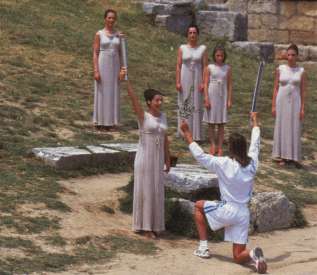 Mike Hewitt - Allsport Lambros Papakostas kneels in front of the chief priestess in Olympia. After a special lighting ceremony at the sacred site, the Greek athlete was the first runner to carry the flame toward Sydney.
A special charter aircraft operated by the official carrier, Ansett, transferred the Olympic flame in a safety lantern directly from Athens to the Pacific Ocean island of Guam for the commencement of the Oceania segment of the Sydney 2000 Olympic Torch Relay, arriving there on 22 May. On Day 11, as the relay came to the Cook Islands, the torch passed through a guard of honour of those who had contributed to the Olympic Movement in that country. The first bearer was carried on a royal platform while children sang a traditional chant. The torch relay left behind the palm trees and beaches of Tonga on 2 June; next stop was the ski-fields of Queenstown on New Zealand's south island. 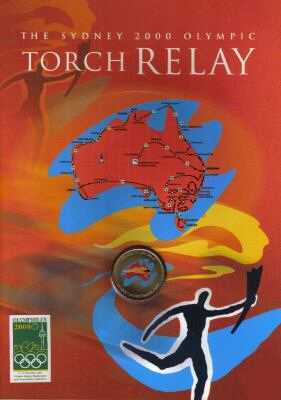 On the morning of 6 June, Day 16, at 10 am the torch reached Wellington Airport. The torch was greeted with a traditional Maori welcome, which with its tongue-poking, glaring eyes and spear-shaking can be rather alarming to the uninitiated. The last stop on the New Zealand leg of the
relay was at Auckland, sometimes described as 'the city of sails' for it,
like Sydney, enjoys the distinction of a vast harbour. Australia In Australia the torch relay passed within an hour's drive of 85 per cent of the population, travelled over 27 000 kms and was carried by 11 000 torchbearers in the longest torch relay in Olympic history. The Olympic flame travelled by a variety of modes of transport, including a surf boat at Bondi, the Indian Pacific train across the Nullarbor Plain, a Royal Flying Doctor Service aircraft in the remote outback and by camel on Cable Beach at Broome in the north-west of the country. The journey began in Uluru, in the centre of Australia. 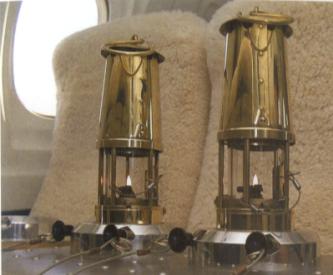 Greg Garay - SOCOG The flame, while in transit, files first class in a safety lantern Northern Territory The arrival of the Olympic torch was preceded by an entourage of international media, every move carefully orchestrated by local officials. On the eve of the flame's arrival guests attended a special staging of an award-winning tourist attraction, a 'Sounds of Silence' dinner, hosted by the President of SOCOG and New South Wales Minister for the Olympic Games, the Honourable Michael Knight. On 8 June 2000 the Olympic flame arrived at Yulara, in Uluru-Kata Tjuta National Park. Announcing Uluru-Kata Tjuta as the first place in Australia to receive the flame, the SOCOG President had declared it important that the site be an instantly recognisable, internationally known symbol of Australia. "Uluru is not only known worldwide but is also a place of immense historical and cultural significance," he noted. "It is in the geographical heart of Australia, is of great spiritual significance to many Australians and is part of the outback character of Australians." The next day the torch left town on a road train convoy, headed back to the airport for its journey into Queensland before returning to the Territory 19 days later. 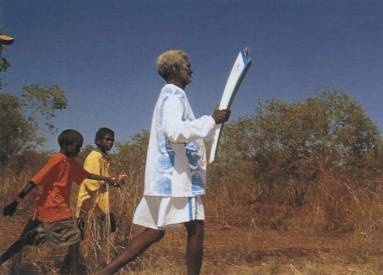 Greg Garay - SOCOG A local Aboriginal torchbearer runs with the torch, escorted by two young boys on his leg of the relay on Day 22 |
| Description: | The tree layers represent earth, fire and water |
|---|---|
| Material: | Three layers consisting of polished stainless steel, anodized aluminum and coated aluminum. |
| Fuel: | |
| Torch measure: | Lenght: 77 cm Weight: 1,000 gr |
| Torches total: | |
| Design by: | Blue Sky Design |
| Manufacturer: | G.A. & L. Harrington Pty Ltd. |
| Date of the torch relay: | 10.05.2000 - 15.09.2000 |
| Duration: | 129 days |
| Numbers of runners: | about 11,000 |
| Distance total: | about 27,000 km |
| Name of the last runner: | Cathy Freeman |
On 9 June, Mount Isa became the flame's first stop in Queensland, when Frank Daisy, a rugby league football legend, became the first to carry the torch in the state. Citizens turned out in droves to greet the flame, the crowds larger than for the mining town's annual rodeo. Like so many towns along the route, Mount Isa's history has both shaped and reflected that of the nation. Last century there were bloody conflicts between its Kalkadunga Aboriginal people and the early European settlers. Now there's a diverse population, which includes Australia's largest Finnish community.
As the torch headed south next morning along the highway through Greenmount and Allora to the agricultural town of Warwick, crowds again turned out in large numbers to cheer the runners on, even before breakfast. A local pub put on a champagne breakfast which proved so popular that people had to be turned away. Most were happy just to be there, with their Australian flags and fold-up picnic chairs. The route now turned towards the coast. The contrasting environments of sea and outback have figured prominently in the way Australians perceive themselves. It was fitting that the Australian leg of the torch relay begin in one environment and move towards the other. Locals were out in force as the torch and its convoy passed through Aratula, Boondah, Beaudesert, Canungra, Nerang, Tugun, Bilinga and Kirra, before arriving at the resort town of Coolangatta. Like so many of the towns the torch passed through on its Australian odyssey, Coolangatta got its name from the local Aboriginal language.
In Brisbane on 14 June, retired Australian cricket captain Alan Border ran the flame in Australia's third largest city. Another well-known runner, rugby league legend Wally Lewis, former Queensland and Australian captain, remarked, "You can pretend you're above all this stuff but no one who carries the torch is unaffected." All those who touched the torch were in turn touched by it, and not only on the day of their run. In Queensland and elsewhere many torchbearers would later take their torches to youth detention centres, nursing homes and schools to share them with others.
After proceeding through a chain of towns stretching northward from Brisbane to the Sunshine Coast, a flotilla of small watercraft greeted the torch in the resort town of Noosa, on Day 9, 16 June. Later, a few kilometres inland, Olympic sprinter Raelene Boyle lit the cauldron at Tewantin. And on the other side of the Pacific, in a symbolic gesture, Nova Peris-Kneebone, the first runner in Australia, handed a torch replica to Muhammad Ali, the last torchbearer of the 1996 Atlanta Games. Earlier on Day 9 Bob Tisdall, aged 93 and the oldest surviving Olympic champion in the world, admitted to being a bit puffed after his 500 m run into the Nambour showgrounds through a cheering crowd. In 1932 he was an Irish hurdles champion, competing at the Los Angeles Games; by now he had been an Australian for over a quarter of a century.
On Day 17, 24 June, legends of Australian swimming made a big splash at Townsville's Tobruk Pool, where they had set world records in training for the Melbourne 1956 Games. On this day, Murray Rose, John Konrads, Jon Henricks and Lorraine Crapp swam a relay in the pool against local schoolchildren, before swim coach Laurie Lawrence lit the cauldron. Next day, the sun shone in Tully for the arrival of the torch, in the town the locals boast is the wettest in Australia. It receives an average annual rainfall of 4200 mm. The torch relay continued north and finished the day in Innisfail, where champion triathlete Brad Bevan ran the final leg into the local park.
The next day, the torch relay travelled out to the Great Barrier Reef, an area of coral reef extending 2000 km along the east coast of Australia, made up of more than 2900 individual reefs and 900 small islands and home to more than 400 different types of coral. The best way to see the reef is by diving on it, so the Sydney 2000 Olympic Torch Relay team took the flame diving. On Agincourt Reef, Wendy Craig Duncan, a marine biologist, took the flame for a 2 minute 40 second diving adventure. A special flare burned at 2000°C, ensuring a bright flame easily visible to the local fish and underwater photographers.
Escorted by a flotilla of boats, the flame then entered the harbour of Port Douglas where elders of the Yalanji Aboriginal tribe sang a traditional song of the sea to welcome it to their shores. Next morning the flame was back on an aircraft; flown to Horn Island, it was put on a pearl lugger and ferried across to Thursday Island to be greeted by Joseph Wasaga, an elder of the Kaurareg people.

|
by the Sydney Opera House and the curves of a boomerang. The three layers of the torch represent earth, water, and fire. |
| New South Wales
15 August, Day 69, was the first full day for the Olympic torch in the Olympic state. From the moment 88-year-old Merrick Webb set off in a dawn downpour from Albury in a wheelchair, thousands lined the long route all the way north to Griffith that evening. From Griffith the flame continued south-east to Wagga Wagga for the evening celebration on August 16, greeted by most of the population of 50 000 in this regional hub that supports dairy, lamb and wheat industries. On the following morning, Day 71, the torch continued north-east to Junee and on to Cootamundra, the birthplace of Sir Donald Bradman, Australia's most famous sportsman and cricketer. 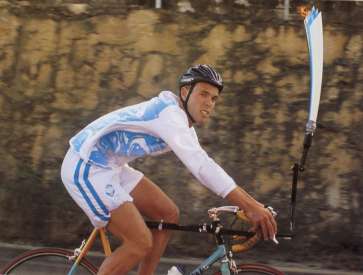 Grag Garry - SOCOG The torch winds its way through the Blue Mountains, part of the Great Dividing Range and a popular tourist destination, by bicycle. On 21 August, the torch headed to Armidale, a university city situated high in the northern tablelands in an area known as New England, for the evening celebration. Leaving Armidale on Day 76, the torch relay travelled north to Tenterfield, the birthplace of Australian Federation and the international entertainer Peter Allen. The celebrations included the singing of his popular song, 'I Still Call Australia Home', which resonates with a special meaning for many Australians. The flame continued to South Kempsey for lunch on Day 79 and Port Macquarie for the evening fireworks. In Port Macquarie, Stephen Lyons, who was born with no legs and one arm, carried the torch. Like most torchbearers, he wanted to keep his torch as a souvenir, so his friends bought it for him. There were similar stories of courage and kindness in numerous other towns. Next day it was Taree for lunch and Tuncurry for dinner, after 80 days on the road in Australia. On Sunday 27 August, Day 8 1 , the torch relay ran south from Forster through Bulahdelah, Karuah and Raymond Terrace before it reached Newcastle for the evening rest. On Day 90, Tuesday 5 September, the relay ran south to Canberra in the Australian Capital Territory. Canberra, the nation's capital, is a purpose-built city, elegantly landscaped, with innovative architecture. Canberra is also home to the Australian Institute of Sport, where many Olympic athletes have trained. Many athletes, including Olympians and Paralympians amongst their ranks, carried the Olympic torch throughout the Canberra region. On 10 September, as the flame continued north towards Sydney, it made its evening stop at seaside Kiama, home to the famous 'blowhole'. Australian surfing legend Tom Carroll, chosen because of his connection with South Coast surfing, lit the community cauldron. Further north, as the torch relay left the city of Wollongong, 100 Harley Davidson motorbike riders made a corridor through which the torchbearer ran. On Thursday 14 September, the day before the Opening Ceremony, the flame was at Bondi Beach, passing from one lifesaving boat to another in the famous surf before lifesaver Jessie Miley-Dyer rode a wave in her boat to carry the torch ashore. The crowds throughout the Sydney leg of the relay were almost overwhelming. Australian swimming legends from the Melbourne 1956 Games, Dawn Fraser and Murray Rose, renowned for their speed in the pool, refused to be hurried by officials and set their own idiosyncratic pace along the streets with the torch. The Opera House forecourt and surrounding Circular Quay were full to capacity with people straining to get a glimpse of proceedings.  Mark Horsburgh - Sport the Library Hours before travelling to Hemebush Bay via fery, 100.000 have gathered on the beach in Manly for the largest lunchtime celebration in the 100-day journey Prince Albert of Monaco ran a section on the Sydney Harbour foreshore, and at the Sydney Opera House the flame was held by blind Italian tenor Andrea Bocelli, who would later perform at the special Opera House Torch Gala Concert. He was accompanied on the outdoor stage by torchbearers Olympian Melinda Gainsford-Taylor and pop star Olivia Newton-John. Newton-John carried the flame around the Opera House and met up with Australian tennis ace Pat Rafter. Their backdrop was the Harbour Bridge, lit for the first time with the five Olympic rings and highlighted by fireworks exploding off the bridge pylons. Day 100, 15 September, was the last day of
the torch relay. With the Opening Ceremony to take place in the evening,
crowd excitement and exuberance surrounding the torch was reaching a crescendo.
Thousands of people ignored security and broke barricades to get a closer
view of the Great White Shark, Australia's golfing great Greg Norman, carrying
the torch on the Sydney Harbour Bridge. After walking slowly through the
crushing crowd, he passed the torch to Paralympian Louise Sauvage. |
| Opening Ceremony and the Olympic Flame
Finally came the entry of the Olympic Flame as Tina Arena sang 'The Flame', signalling the last stage of a relay which had begun in Ancient Olympia nearly five months earlier, and had explored 27 000 km of Australia during the previous 99 days. It had been carried by nearly 11000 torchbearers in Australia, and generated enormous goodwill. Now, inside the stadium for its final lap, it was in the hands of a medley of some of Australia's greatest female athletes. This carriage of the last torch was designed to commemorate a century of women's participation in the Games. Appropriately, it also served as a reminder of the huge contribution women have made to Australian Olympic history. Betty Cuthbert, heroine of the Melbourne 1956 Olympic Games and now a victim of multiple sclerosis, was the first torchbearer inside the stadium, in a wheelchair pushed by Raelene Boyle. The torch went then to legends Dawn Fraser, Shirley Strickland and Shane Gould before being passed to Debbie Flintoff-King, the last Australian woman to win gold on the athletic track before Sydney. Between them the members of that group have won 15 gold medals. Each had a short, dignified run with the precious cargo before a hug and a changeover. When Flintoff-King handed the torch to Cathy Freeman, clad in a space-age body suit, the huge audience erupted with a massive roar of delight and excitement. For more than a year the identity of the last torchbearer had been the subject of intense speculation and anticipation. The choice of Freeman meant that the Australian relay, which had begun with one indigenous Australian, Nova Peris-Kneebone, had ended with another. At the end of a ceremony that had emphasised Aboriginal heritage and addressed the issue of Reconciliation, the presence of Freeman in such a vital role made a powerful statement. Many saw it as representing a special moment in the nation's history. Freeman ascended four flights of stairs, carrying
the torch, then walked across a shallow circular pond to an island in the
centre, where she dipped the torch low, then swept it around her to ignite
a ring of fire. The pond in fact concealed the submerged cauldron, and
the circle of fire consisted of 150 nozzles around the rim of its gas-burner.
As she stood motionless, the now-flaming cauldron rose around and above
her. The whole tableau amounted to a lovely marriage of fire and water.
Freeman walked from the pond and stood solitary, torch aloft, for what
seemed an eternity, as the cauldron waited to be transported towards its
place above the stadium. Finally it made its slow, majestic voyage upwards,
via a winch system, against a waterfall background. The Games of the XXVII
Olympiad had their flame for the next 16 days. Sydney, and Australia, had
a memory that would last for at least 110 000 lifetimes. (Source document: Official
Report 2000, vol. II ) |
firing the spirit The Sydney 2000 Olympic torch
read more: Bearing the flamme Thank you to the Powerhouse Museum, Sydney |
